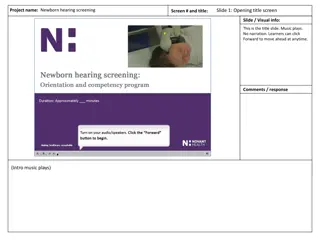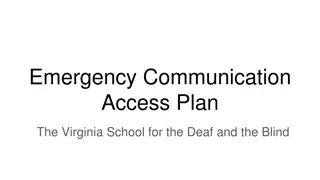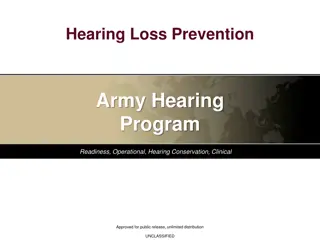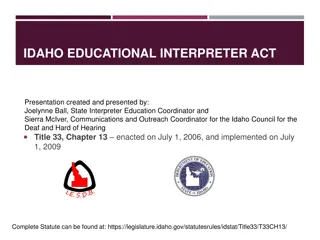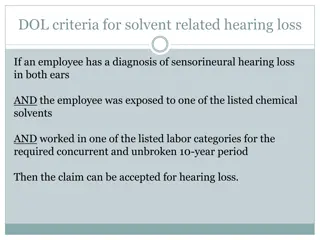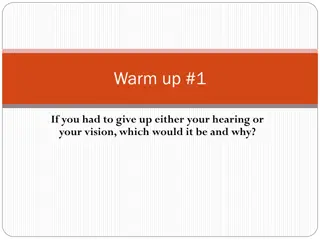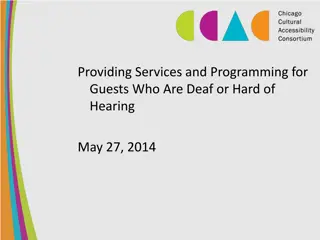Teaching Basic Concepts to Deaf/Hard-of-Hearing Children
Teaching basic concepts is crucial for deaf/hard-of-hearing (D/HH) children as it forms the foundation for learning and thinking. These concepts—such as location, number, descriptions, time, and feelings—are best learned through concrete examples. D/HH students benefit from focused, one-at-a-time instruction and specific strategies like concept isolation, positive and negative examples, and more to enhance their understanding.
Download Presentation

Please find below an Image/Link to download the presentation.
The content on the website is provided AS IS for your information and personal use only. It may not be sold, licensed, or shared on other websites without obtaining consent from the author.If you encounter any issues during the download, it is possible that the publisher has removed the file from their server.
You are allowed to download the files provided on this website for personal or commercial use, subject to the condition that they are used lawfully. All files are the property of their respective owners.
The content on the website is provided AS IS for your information and personal use only. It may not be sold, licensed, or shared on other websites without obtaining consent from the author.
E N D
Presentation Transcript
Teaching Basic Concepts to Children who are Deaf/Hard-of-Hearing Grace Amerman, MA Mama Lere Hearing School at Vanderbilt University
What are Basic Concepts and why are the important? Basic Concepts: Words that are most easily learned through concrete examples. They depict location (up/down), number (more/less), descriptions (big/little), time (old/young), and feelings (happy/sad). Basic Concepts are the basic building blocks of thinking and learning in early education. The are a precursor to higher level thinking as they require the ability to compare and contrast.
What does this mean for our D/HH students? As we know, D/HH children do not typically experience incidental learning. Their typical hearing peers do, so basic concepts are taught differently in general early childhood education. As professionals who work with D/HH students, we should focus on teaching one concept at a time so that it may become more concrete for our students.
How? According to Nelson, Powell, Bloom, Lignugaris/Kraft (2014), basic concepts can be taught using 6 simple strategies
1. Concept Isolation Introduce only one concept at a time Think of auditiory bombardment during the introduction of your concept. Your students should hear the concept name many times and you should challenge yourself to see how many times you can say it. Example: Today we are going to talk about the word on. Now you say the word on (students say on). Good! Now we are going to talk about what the word on means. Let learn about the word on. Everyone sit criss-cross apple sauce on the rug so that we can learn about the word on. Hey, I used the word on. Did you hear me say, sit criss-cross apple sauce on the rug ? We are sitting on the rug etc. It would also be beneficial for some students if the teacher acoustically highlighted the concept word during the introduction.
2. 5 Positive Examples Show 5 examples of what the concept is Example: This red bear is on the rug. This blue bear is on the table. This green bear is on the chair. This yellow bear is on my head. This orange bear is on your head. This is best done with 3-D manipulatives (in the above example the counting bears would be a good manipulative.
3. 5 Negative Examples Show 5 examples of what the concept is not Example: This red bear is not on the rug. This blue bear is not on the table. This green bear is not on the chair. This yellow bear is not on my head. This orange bear is not on your head. Again, this is best done with 3-D manipulatives (the same manipulative you used to demonstrate the positive examples).
4. Continuous Conversation This is your opportunity to allow the student to show you what they understand. Receptive: Ask the student, Show me, the bear is on the rug (the student should model with the manipulative). Good, Where is the bear? and the student should respond appropriately using the basic concept you ve targeted. Expressive: Put the bear on the table. Ask the student, Where is the bear and the student should respond appropriately using the basic concept you ve targeted. Have fun with this, allow the student to be the teacher and quiz you on the concept. If the student practices higher thinking then sabotage may be appropriate to use so that they make correct your mistake.
5. Teaching Generalization Throughout the Day Find different ways that you might be able to incorporate your basic concept into different times of your day. Lunch Time: Can you go put the napkins on the table? Always test expressive after receptive, Good! Where did you put those napkins? and the student should tell you they put them on the table. Story Time: Look for examples of the concept in the story that you read. Point out a few examples and then see if the students can find their own examples of the concept. Free Play: Watch for the student to carry it over into their spontaneous play (this won t happen right away but it will when they are comfortable with the concept) and see if you can help them along. Example, put the pretend keys on top of play stove while in housekeeping. Say, I want to go to the store but I can t find my keys. Do you see my keys? This will hopefully set the student up to tell you that they are on the stove.
6. Facilitating Spontaneous Recall This is where we strategically plant reminders of the concept throughout the child s environment. An example of this would be using place mats at snack time with different pictures of faces expressing different emotions on them. This would help facilitate some spontaneous discourse about the concept you ve been working on. It is also a way to check and see if the student is generalizing it outside of the lessons. Ideally the student would observe that the boy on his place mat is sad and the girl on the other place mat is happy. To promote higher level thinking the teacher could ask why the student thinks the boy is sad.
Tips When engaging in conversation about the concept, only use known words so that you can be sure the student is only focusing on learning this concept and not new words. An example would be, if the student is learning big and does not know small, then use the term NOT big when discussing something that is small while you are providing negative examples. Carefully select your order of teaching concepts from more concrete to abstract Review previously taught concepts throughout the year When showing positive examples, with objects, there needs to be a way to show differences. Example put a bear under a table and a zebra under a different table. Do not hesitate to modify instruction based on your students needs to assure that learning occurs.
Resources Basic Concept Training: Nelson, Powell, Bloom & Lignugaris/Kraft, 2014) Teaching Basic Concepts for Early School Success! Keri Spielvogle, M.C.D., CCC-SLP I received training on teaching basic concepts following this method from Michael Douglas, MA, CCC-SLP, LSLS, Cert AVT.


